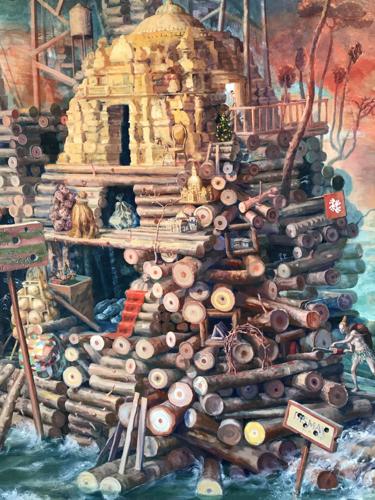Julie Heffernan's work provokes viewers to think about what they would do if melting polar ice caps caused oceans to rise.
Baton Rouge area residents know about rising water from last August's flood. But in the world of Heffernan's latest series, everyone is seeking a solution.
Her exhibit, "When the Water Rises: Recent Paintings by Julie Heffernan," runs through Sept. 17 at the LSU Museum of Art.
"She offers creative alternative habitats in response to climate change and planetary excess," says curator Courtney Taylor. "You'll see communities in trees and people living on rafts."
And there are tiny, interior worlds within the paintings that reflect and comment on the human condition.
"The landscape becomes the mind and body," Taylor says. "And it's all framed in an old master's way. It's as if this is a window, and you're looking into it."
In an interview in the museum's quarterly "Art Talk," Heffernan expands on what might happen if her paintings move viewers to act on climate change.
"This is why we read novels," Heffernan says. "The arts exist to be extensions of the brain and the brain's shortcomings. We read novels not to gain information but to gain empathy, and if it's a good novel, to enter into another person's experience."
Heffernan adds that sometimes the imagination runs a little wild.
"But sometimes the imagination helps us prepare for a different kind of world," she says. "I'm hoping these paintings provide a sensorial experience of the predicament — you know, we're up in a tree, and we're kind of stuck because down below is a ravaged world … what would it be like to be stuck in a tree?"
But the artist doesn't stop there.
"Heffernan presents a vision of a world in transition — the past is gone, the future is unclear and the stops toward a new stability are uncertain," contributing editor Eleanor Heartney of Art in America writes in the exhibition catalog. "There is no guarantee of success, as works like 'Self-Portrait as Castaway' suggest. Here the fiery landscape offers no respite to the desperate voyagers setting off into the unknown."
In other paintings, the scene is tranquil.
"In other works, like 'Requiem for Palmyra,' the wanderers seem to have discovered a kind of Shangri La, a gigantic mound that holds talismans of memory and lost relics that provides balm to body and soul," Heartney writes.
Still, there is room for hope.
"While much has been lost, Heffernan does seem to promise a reset," Heartney writes. "Catastrophe has permitted a return to a state that prevailed before the expulsion from paradise, and hence before the onset of what has been termed the theology of 'Dominionism.' "
The idea of dominionism is based on a passage in Genesis in which nature is subjugated to human needs.
Heffernan, Heartney concludes, imagines a reality that places humanity back into nature.
"No longer its master, we are now its progeny and partner," Heartney writes.
Finally, in creating this body of work, Heffernan says she isn't creating commercial products.
"… I want to make things that are vitally important to everything that I believe in," Heffernan says in the "Art Talk" interview. "… On the other hand, a museum provides a realm of contemplation as opposed to a showcase for one's wealth … and that's the kind of position I want to speak from."
When the Water Rises: Recent Paintings by Julie Heffernan
WHEN: Through Sept. 17. Noon to 5 p.m. Tuesday, Wednesday, Friday and Saturday; noon to 8 p.m. Thursday; 1 to 5 p.m. Sunday.
WHERE: LSU Museum of Art in the Shaw Center of the Arts, 100 Lafayette St.
ADMISSION: $5, age 13 and older. Free for age 12 and younger and university students with ID. Free for everyone the first Sunday of every month.
INFORMATION: (225) 389-7200 or lsumoa.org










